Ceramic shower tray - the features of this option and the
Shower cabins have become a very common solution for both small rooms and spacious bathrooms. This design can replace a bath, and can be used in conjunction with it, because if you need to quickly take a shower or refresh yourself in the summer heat, then the cabin is exactly what you need.
Modern models are equipped with various components, but one of the main elements is a pallet - the operational safety and durability of the entire system largely depend on it.

Main design differences
All products differ in a number of factors, the main of which is the form. Most often you can find the following options:
| Square | The classic version, which is suitable for a variety of environments and is considered to be a universal solution. Dimensions can vary in a wide range - from the most compact versions of 70x70 and beyond. It is not recommended to choose too large models, the ceramic shower tray 100x100 is the maximum that should be considered, then the price rises unnecessarily high. |
| Rectangular | This solution is also very attractive and in demand because, with its help, you can use the space as efficiently as possible. For example, if you have a niche with a width of 1.2 meters, then a ceramic shower tray 120x80 will fit there perfectly; this configuration allows you to be very comfortable. |
| Semicircular | This option is installed in the corner, and its outer side is a rounded corner. This layout allows you to expand the passage in a limited space, which is very important for comfort and safety, because the bathroom floor is often slippery, and any corners are potentially traumatic. |
| U-shaped | This option is suitable for positioning the structure in the middle of the wall, since access will be provided on both sides, and the structure itself will look equally good from anywhere in the room. Simply put, this option is ideal if the booth is adjacent to only one wall. |
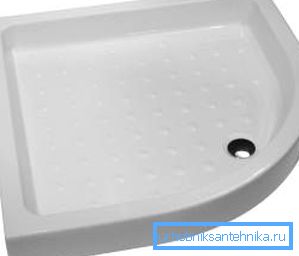
Other parameters are also important:
- Dimensions of construction - they are selected individually in each specific case and should be determined on the basis of their place of installation, the characteristics of the room - its area and configuration. In any case, options less than 70 cm in size should not be considered - they are cramped and uncomfortable.
- Height of sides It is also very important, the higher they are, the less likely it is that water will splash, but it will also be more difficult to enter the booth. In some embodiments, a pedestal may be provided on which to sit during hygiene procedures.

- Quality ceramics It is of fundamental importance, since this material turns out to be too fragile if the manufacturing technology is not followed. Therefore, we recommend choosing products of well-known manufacturers that have proven themselves among buyers and specialists.
Note! Another important tip is to choose a design with a grooved surface to reduce the likelihood of slipping and falling.
Installation technology
You should not believe people who claim that ceramic structures are very fragile, the same acrylic pan is much easier to break through. Compliance with basic care ensures that the product will serve you for many years. The main thing is to carry out the installation work correctly, and that is what we will consider.
Preparatory stage
The most important feature that ceramics possess is the fact that they are not placed on a special frame or pedestal, but simply glued with a solution on the prepared surface. This is both an advantage and a disadvantage, as the installation of a ceramic shower tray with your own hands is very different from other options.
Consider the whole process from start to finish:
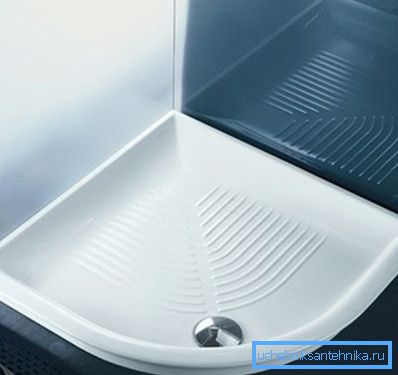
- First of all, the surface is prepared, there can be two options: either you make a screed and level the required area before tiling, or you put ceramics over the entire area, but somehow you need to cut a niche in the floor and equip it a kind of hatch. Alternatively, the space can be covered with tiles or part of it.
- The site should correspond to the size of the pallet, if you have leveled it with the help of a solution, then you can continue to work after they have gained sufficient strength characteristics. If the height of the pallet is enough, the pipe can go along the surface, for low structures it is necessary to chop or cut the floor. At the same time try to bring the pipe as close as possible to the location of the drain hole, this will simplify the work.
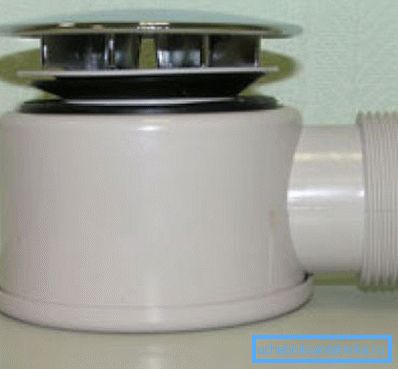
- The pipes are laid at the stage of pouring the screeds, and a siphon may require a recess (if the height of the pallet is small). Constructions of water locks are made in such a way that, if necessary, they can be very easily and quickly cleaned by simply removing the mesh in the upper part. It is important to choose a reliable and durable siphon with a service life of at least 10 years.
Note! You must consider what size of the pallet will be installed even when laying sewer pipes, since the size of the outlet of the pipe directly depends on its dimensions.

- The last stage, carried out in the framework of preparation, is the treatment of the base to give it increased strength and moisture resistance. For this, either an aqueous solution of PVA glue or special primer compositions with the addition of hydrophobic additives that provide excellent protection against moisture will be suitable.

Pallet installation
This type of work is performed in the following sequence:
- First of all, a siphon is attached to the structure, the location of which should coincide with a recess in the floor. Sometimes you can get out of the situation as follows - the pipe is brought not under the pallet, but next to it, and hides under the tile or under a specially installed hatch. And the water lock is selected with a flexible liner, with which you can go to any place, as long as the length of the structure allows it.
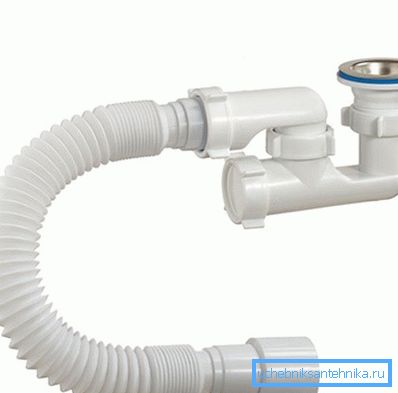
- Further the basis is greased with cement mortar or glue for a tile, the instruction on packaging will prompt the features of mixing of structure. The pallet is neatly placed on the surface and left for about a day, this is enough for the composition to completely solidify and to secure the structure.
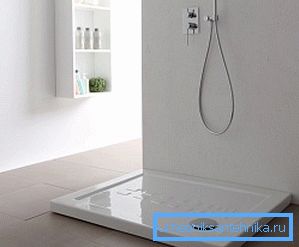
- After that, the siphon is connected to the sewer, and the system is checked for leaks by draining a bucket of water.
- At the very least, all abutments to the wall are sealed; this is done with a special sealant resistant to mold and mildew.
Conclusion
The video in this article will help to understand the features of the workflow even better and will tell you how to install the system correctly and quickly. After all, ceramic pallets are among the most attractive.